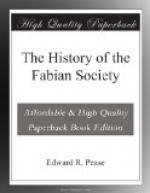In 1893, and even before, the Fabian Society had urged the Trade Unionists to form a Labour Party of their own, and earlier in the same year the Independent Labour Party had been founded which was originally intended to achieve the object indicated by its name, but which quickly became a purely Socialist society. It carried on a vigorous and successful propaganda amongst Trade Unionists, with the result that in 1899 the Trade Union Congress passed a resolution directing its Parliamentary Committee, in co-operation with the Socialist Societies, to call a conference in order “to devise ways and means for securing an increased number of Labour members in the next Parliament.” In accordance with this resolution the Society was invited to appoint two representatives to meet the delegates of the Parliamentary Committee and of the two other Socialist organisations. Bernard Shaw and myself were appointed, and we took part in the business of arranging for the Conference. This was held on the last two days of February, 1900, and I was appointed the one delegate to which the Society was by its numbers entitled. The “Labour Representation Committee” was duly formed, and it was decided that the Executive Committee of twelve should include one elected by the Fabian Society. This Committee was constituted then and there, and, as “Fabian News” reports, “Edward R. Pease provisionally appointed himself, as the only Fabian delegate, to be on the Executive Committee, and the Executive Committee has since confirmed the appointment.” This little comedy was carried on for some years. The Fabian Society was only entitled to send one delegate to the annual conference, but that delegate had the right of electing one member to the Executive Committee, and I was appointed by my Committee to serve in both capacities. But the incident embodies a moral. The Trade Unionists on the Committee represented in the earlier years about 100,000 members each: I then represented some 700. But although it was often proposed to amend the constitution by giving every vote an equal value, the Trade Union leaders always defended the over-representation of the Socialists (the I.L.P. were also over-represented, though their case was not so extreme) partly because the Labour Representation Committee was founded as a federation of Socialists and Trade Unionists, and partly because Socialist Societies, consisting exclusively of persons keenly concerned in politics, were entitled to larger representation per head of membership than Unions which were primarily non-political. But when we remember how attractive to the average man are broad generalisations like “one vote one value,” and how plausible a case could be made out against discrimination in favour of Socialist Societies, it has always seemed to me a remarkable example of the practical common sense of organised labour that the old constitution has been preserved, in fact though not precisely in form, to the present day. By the present constitution the “Socialist Section” elects three members to the Executive from nominations sent in advance; but as the I.L.P. always makes two nominations, and the Fabian Society one, the alteration of the rule has not in fact made any change, and the over-representation of this section is of course undiminished.




